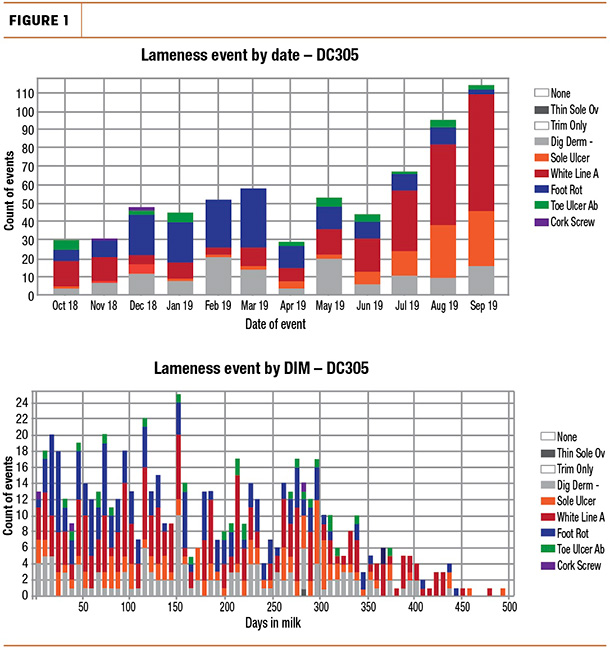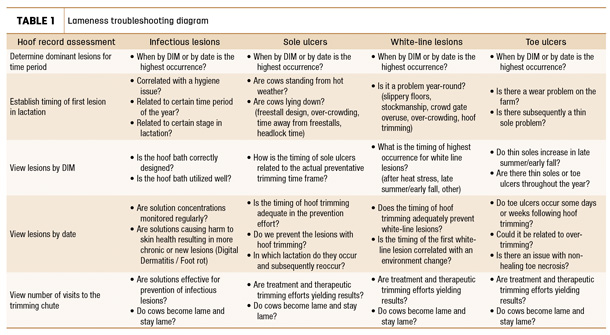“How can I recover more of my lame cows?” That is a question posed to hoof care professionals by dairy producers frequently.
The answer at face value is rather simple: Managers must focus on proactively preventing the lesions that affect the majority of their herds. For most farms worldwide, this includes three hoof horn lesions (sole ulcers, white-line lesions and toe ulcers) and two infectious lesions (foot rot and digital dermatitis). Having an in-depth understanding of what causes these hoof horn and infectious lesions is imperative to successfully prevent them.
- Sole ulcers – An important factor directly related to a higher incidence of sole ulcers is increased standing time. This can be due to poor freestall design, increased time away from the pen for parlor visits, too much headlock time, poor heat abatement, overcrowding and lack of functional hoof trimming. In turn, to control and prevent sole ulcers, managers must make a goal for each cow to lie down a minimum of 11 hours per day in a comfortable freestall and promote modern hoof trimming. This includes functional trimming of first-lactation heifers and dry cows three to eight weeks prior to calving with a larger model of the lateral claw. In addition, every cow in the herd should be evaluated one to three times per year depending on the housing environment.
-
White-line lesions – Factors related to higher levels of white-line lesions are slippery floors, uneven floors, slatted floors, organic bedding, livestock handling, overuse of crowd gates, long walking distances, low hoof angle, lack of hoof trimming and incorrect hoof trimming. Secure floors that provide adequate traction, calm cattle handling and promoting modern hoof trimming are all factors that will help in the control of white-line lesions. The graphs in Figure 1 tell us that both white-line lesions and sole ulcers are more prevalent in late summer and early fall as well as in early lactation cows.
 When establishing a lameness prevention action plan, consideration must be given to cows transitioning in summer, where anything related to heat stress may contribute to the underlying cause of lameness.
When establishing a lameness prevention action plan, consideration must be given to cows transitioning in summer, where anything related to heat stress may contribute to the underlying cause of lameness.
- Toe ulcers – Toe ulcers are the result of too much wear and/or overtrimming. In these instances, lesions do not show up in a certain timeframe. Rather, they are distributed throughout the whole year.
- Digital dermatitis and infectious lesions – Infectious lesions are mostly related to hygiene, skin integrity and immunosuppression. When it comes to digital dermatitis, we must look at the chronic lesions that are the drivers of new infections in milking cows. Effective prevention and treatment protocols must be implemented starting in breeding-aged heifers at 10 months old. Use of a regular hoof bath with an effective solution should reduce new infections and control chronic DD from re-infection. In general, foot rot is more prevalent in early lactation or with compromised skin condition around the hoof. Similar to controlling DD, using an effective hoof bath that promotes skin health and integrity is the best defense in combating foot rot.
With all the before mentioned considerations in mind, Table 1 was developed to assist producers in troubleshooting what lameness they are experiencing on farm and how to combat and prevent it.
Today, there is much knowledge and understanding about the causes and prevention of hoof horn and infectious hoof diseases. Implementing effective prevention strategies are essential for success.
When the problems are identified, the cost and benefits must be established to form an action plan.
A simple plan of action addressing the two main lameness issues will guarantee the biggest impact on lameness prevention. Whole strategies will always yield desired results and will reduce the “become lame, stay lame” scenario which affects many dairy cows throughout the world.







